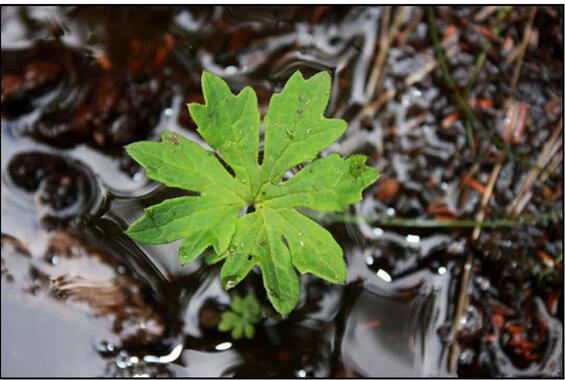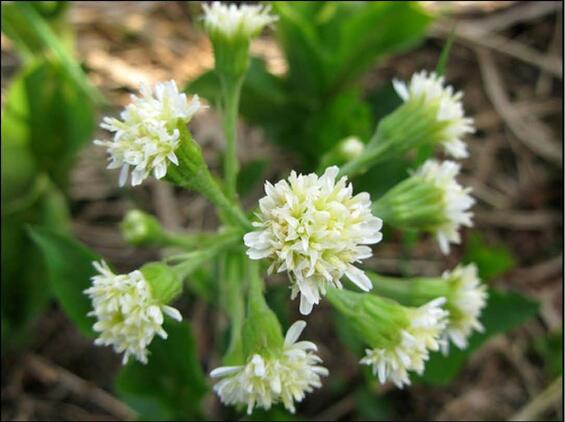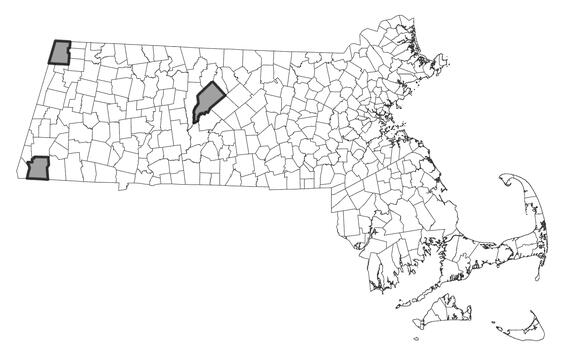- Scientific name: Petasites frigidus
- Species of Greatest Conservation Need (MA State Wildlife Action Plan)
- Endangered (MA Endangered Species Act)
Description

Sweet coltsfoot (Petasites frigidus)
Sweet coltsfoot is a perennial herb with flowering stems 20-35 cm (8-14 in) in height. In Massachusetts, where it rarely flowers, Petasites is most easily identified by its strongly palmate, vegetative basal leaves which bear distinctive, fine, paired purple lines on the stem. Basal leaves may be 50-100 cm (20-39 in) wide, with a petiole up to 100 cm (40 in), and the leaf undersides are hairy. Flowering stems are distinctively hairy, with leaves, with an inflorescence consisting of up to 20 flowering heads.
The basal leaves of Petasites frigidus may be confused with buttercups (Ranunculus) or geraniums (Geranium spp.), which may have a similar palmate arrangement. Both groups typically lack the rounded lobes of P. frigidus and the paired purple lines on the basal leaf petiole. Butterbur (Petasites hybridus), one of three living species in the genus, is a European species that has been documented in eastern Massachusetts and Hampden County (Magee and Ahles 1999). Its cordate leaves more closely resemble those of coltsfoot (Tussilago farfara), an invasive species from Europe that is closely allied to the Petasites clade and occurs with P. frigidus.
P. frigidus occurs with a mix of temperate and boreal canopy species dominate these sites, including white pine (Pinus strobus), hemlock (Tsuga canadensis), yellow birch (Betula alleghaniensis), and balsam poplar (Populus balsamifera). Co-occurring herbaceous species include Christmas fern (Polystichum acrostichoides), maidenhair (Adiantum pedatum), Chinese hemlock-parsley (Conioselinum chinense), and grass-of-Parnassus (Parnassia glauca).
Life cycle and behavior
This is a perennial species.
Population status
Sweet coltsfoot is listed under the Massachusetts Endangered Species Act as endangered. The Massachusetts Natural Heritage & Endangered Species Program has 12 records from 5 counties: Berkshire, Franklin, Hampshire, Norfolk, and Worcester. Four of these records have been observed within the last 25 years.

Sweet coltsfoot flowering stem.
Distribution and abundance
P. frigidus is widely distributed in forested, tundra, and alpine habitats across subarctic North America, from Labrador to Alaska south to Connecticut, Michigan, Wisconsin, and the mountains of California. The species is uncommon in the high arctic of North America but occurs on some Canadian arctic islands. P. frigidus occurs throughout boreal Eurasia, including Svalbard, and on some Siberian Arctic islands, including Wrangel Island (e.g., Porsild 1957; Magee and Ahles 1999; Aiken et al. 1999). The European variety is var. frigidus, which differs from our var. palmatus in having pinkish-white flowers and less strongly dissected leaves.

Distribution in Massachusetts. 2000-2025. Based on records in the Natural Heritage Database.
Habitat
P. frigidus historically occurred in forested swamps and calcareous fens at a dozen sites throughout the mainland portion of the state. Several historic locations in the Connecticut River Valley occurred in nondescript, forested wetlands dominated by red maple (Acer rubrum) and other temperate canopy species. In eastern Massachusetts, historic data are vague and it is difficult to determine the former habitat associations of P. frigidus in those areas. Where the species persists in Berkshire County, it occurs on seepages in sloping, calcareous forested habitats, sometimes occurring over a continuous area greater than one acre.
Healthy habitats are vital for supporting native wildlife and plants. Explore habitats and learn about conservation and restoration in Massachusetts.
Threats
Potential threats to sweet coltsfoot in Massachusetts include direct loss of adult plants during forestry activities and trail maintenance or development. Several invasive species, such as coltsfoot, have colonized the remaining populations and may compete with it for space on forested hillsides. As a subarctic species at the southern extent of its range, P. frigidus may respond poorly to shifts in forest community structure caused by regional climate change.
Conservation
The exact management needs of sweet coltsfoot are not known. Known locations should be avoided during forestry activities and monitored for population changes in response to successional changes. Management plans for this species may be developed in consultation with MassWildlife’s Natural Heritage and Endangered Species Program.
References
Aiken, S.G., M.J. Dallwitz, L.L. Consaul, C.L. McJannet, L.J.Gillespie, R.L. Boles, G.W. Argus, J.M. Gillett, P.J. Scott, R. Elven, M.C. LeBlanc, A.K. Brysting and H. Solstaf. 1999. Flora of the Canadian Arctic Archipelago: Descriptions, Illustrations, Identification, and Information Retrieval. Version: April 2003. Accessed September 2009.
Kristinsson, H. 1986. Plontu Handbokin. blomplontur og byrkningar. Islensk natura II. Bokautgafan Orn Og Orlygur; Reykavik.
Magee, D., and H. Ahles. 1999. Flora of the Northeast: A manual of thevascular flora of New England and adjacent New York. University of Massachusetts Press; Amherst.
Porsild, A.E. 1957. Illustrated flora of the Canadian Arctic Archipelago. National Museum of Canada; Ottawa, ONT.
Sorrie, B., and P. Somers. 1999. The vascular plants of Massachusetts: A county checklist. Massachusetts DFW, NHESP; Westborough, MA.
Contact
| Date published: | May 1, 2025 |
|---|